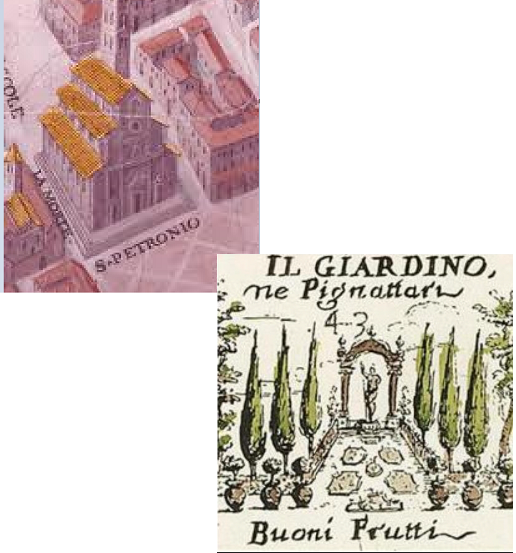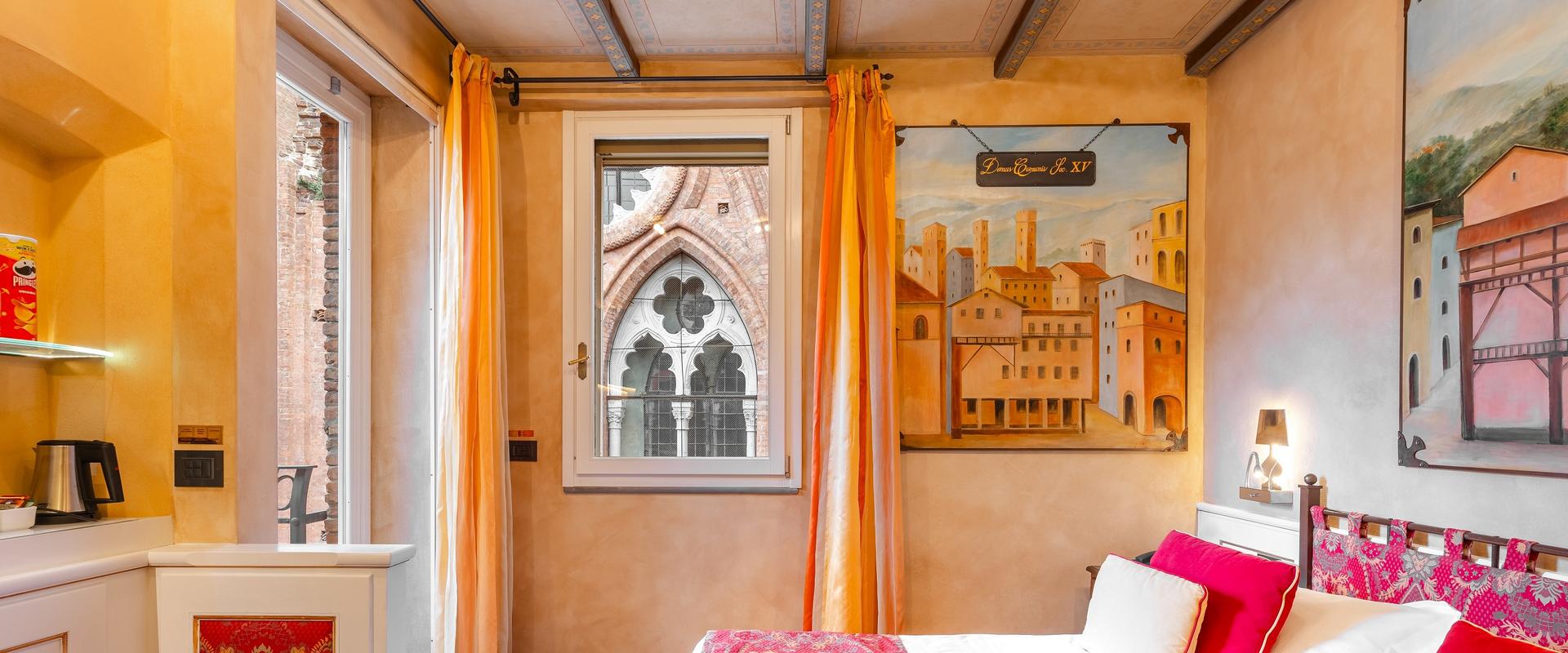Commercianti 艺术酒店拥有数百年的历史,与博洛尼亚的历史中心紧密相连,从未停滞不前,而是一直不断变化。几个世纪以来,其建筑、广场和设施不断改造和翻修,但尽管历史悠久,这座城市依然体现着 16 世纪博洛尼亚人的精神。
我们的历史(据历史线索、古代文献和中世纪编年史等记载)
从过去居民留下的痕迹来看,我们建筑的历史令人着迷。在过去的九个世纪里,每一位居民都曾将其作为住所和工坊,并根据自己的需求不断对其进行改造和重塑。虽然其现在作为酒店的身份可以追溯到 20 世纪,但它最初是
作为一座塔楼诞生于中世纪鼎盛时期,即 11 世纪初,当时建造这种坚固的建筑是为了抵御岁月的磨损和敌人的攻击。时至今日,尽管经过多次翻修,但这座塔楼的起源依然清晰可见:在外部,高高的复合柱和门廊的木制支架依然支撑着最初的外墙;在内部,被古代大火熏黑的横梁至今仍是整个建筑结构的组成部分。
博洛尼亞市中心藝術飯店的歷史
博洛尼亞市中心藝術飯店的歷史
Commercianti 艺术酒店 (Art Hotel Commercianti)......通向 San Petronio 的窗口......
我们的 Commercianti 酒店被认可为博洛尼亚具有历史意义的企业,因其已在同一地点存在了一个多世纪。迄今为止,博洛尼亚商会仅向博洛尼亚的 53 家企业颁发过这一证书。


深挖于地下的水井就是当年围城期间为居民供水的那口井,而用原始“segno a chiodo”(字面意思为“钉痕”)技法创作的壁画,是那些早已被遗忘的富贵家族曾经的辉煌与奢华的全部遗迹。 我们发现的多次翻修过程中的遗迹见证了以前居民的生活和活动。陶器碎片讲述了 Etruscan Felsina 一户家庭的简朴生活;几何图案檐壁和一只神兽浮雕令人想起公元 8 世纪 Aemilia 大区罗马博诺尼亚的奢华;钉子和铁制工具以及一尊陶土小雕像和一些皮纳塔陶罐碎片则暗示着中世纪铁匠和陶器小贩的卑微工作。1116 年见证了博洛尼亚市镇和新的市民自治权的诞生:因此市政当局选择了圣安布罗修教堂(Curia di Sancti Ambrosii)及其附属建筑(即如今我们所在的建筑)作为其市政府(Domus Comunis)所在地。六十三年后,市政府的所在地迁至靠近 Archiginnasio 图书馆的地方,我们的建筑不再是博洛尼亚市政府所在地,被博洛尼亚最著名的两位法律注释学家收购,Alberico di Porta Ravennate 将其作为艺术协会的所在地,而 Odofredo 则将其用作私人住所。按照当时的习俗,两人都在自己家中授课,并直接从学生那里获得报酬。十四世纪末,开始兴建气势恢宏的 Basilica di San Petronio 大教堂,其设计规模甚至超过了罗马的 Saint Peter 大教堂。为了给这座巨型建筑腾出空间,城市中的大部分街区,包括至少八座教堂和塔楼,都被拆除了,而我们的建筑也被列入这一过于庞大的项目的拆迁名单。它最终得以幸免于难,这要归功于罗马教廷,因其禁止建造一座将使基督教的象征——Saint Peter 的形象黯然失色的大教堂。因此,从距离我们窗户仅几米远的未完工的耳堂可以看出,最初的十字形设计被放弃了,大教堂的两翼也从未建成。
圣殿骑士、古旧地籍文献以及古老旅店的旗帜……

让我们再次回到中世纪,谈谈圣殿骑士团,这是另一个与我们建筑的历史息息相关的显赫团体。这个骑士团于 1161 年首次出现在博洛尼亚,并迅速成为这座城市最富有、最有权势的团体之一:其名下拥有大量财产,包括数百英亩的土地、众多宫殿和建筑以及四座教堂,其中包括附近位于 Via De' Pignattari 的 Santa Croce 教堂.
根据教会管理机构的地籍资产清单,有一家客栈
是为朝圣者开设的,我们认为,这家客栈很可能就位于我们的塔楼建筑中。然而,正如所有人类组织不可避免的命运一样,历经辉煌的圣殿骑士团也开始失去权力,逐渐衰落。最终,在1312年,教皇诏书 “Vox in Excelso”和“Ad providam Christi vicarii”宣布解散骑士团,并剥夺了其所有财产。Santa Croce 由获得圣殿骑士没收资产的宗教团体让出,后来被拆除,以腾出空间用于 San Petronio 大教堂的建造。如今,除了大教堂内为纪念它而修建的一座小礼拜堂外,这座教堂任何遗迹都没有留下。幸运的是,其他与 Santa Croce 教堂相关联的建筑(包括我们的建筑)的命运有所不同:由于 San Petronio 教堂的修建工作暂停,它们得以安然无恙地保存下来。此后的四百年间,再也没有人提到过我们的建筑,但在 1712 年 Giuseppe Maria Miteli 创作的名为《博洛尼亚所有酒馆的新游戏》(Giuoco nuovo di tutte le osterie che sono in Bologna)的蚀刻版画中,它再次出现:第十二个方框描绘的是 Via De' Pignattari 花园(当时名为“della Pellegrina”)的旗帜。这个名字是在 1760 年由 Magione di Santa Maria del Tempio 的平信徒修道院长起草的一份租约中发现的。
最后一次回顾历史将我们带到 20 世纪初,当时这家客栈变成了一家酒店,其名字来源于经常光顾附近 Piazza Maggiore 广场上重要的每周市场的商人(commercianti)。如今,Via De' Pignattari 是一条宁静的步行街,但在几个世纪前,它曾是繁忙的街道。它最初是罗马时期典型的东西向街道(其中一段可追溯到公元前 200 年,位于我们门廊的起始处),随着时间的推移,这条街道上聚集了许多重要的场所,使其成为一条热闹的繁华主街。 七世纪时,它被称为 San Ambrogio,由于其宽度在当时罕见,因此成为了街道终点所在广场的一部分。
直到 17 世纪,这条长达两百米的街道根据附近的工业和商铺被分为三个部分,每个部分有不同的名称:“Dazi dal vin”、“Pignattar”和“Dal Salario”。名为“Dazi dal vin”的一段街道上有一支搬运工队伍, 也叫“brentatori”,以他们搬运的“brente”(木质酒桶)而得名。然而,他们不仅仅是普通的搬运工——这些“brentatori”由市议会批准,可以品尝葡萄酒,依据其质量确定价格,然后征收相应的“税费”。名为“Pignattar”的街段以“pignattari”(陶工)命名,他们制作名为“pignatte”的陶罐,这个词源自拉丁语“pinnata”;而名为“Dal Salario”的街段则包含一个盐仓。

在17世纪,这三个街段合并为一条名为“De Pignattari”的街道,尽管由于 San Petronio 大教堂的建造而大大缩小,但仍然与 Piazza Maggiore 广场相连接。与此同时,这座辉煌的中世纪广场已成为博洛尼亚的中心,市民们会聚集在这里,聆听从 Podestà 阳台上宣布的法令和条例。广场及其周围的街道上挤满了寻求娱乐和生意的人们,为在这里举行的许多骑士比武、庆典和表演提供了热闹喧嚣的环境。时至今日,Via De'Pignattari 路仍因毗邻 Piazza Maggiore 广场而受益,该广场是每个博洛尼亚人都有归属感的公共空间。如今,广场举办这座城市最重要、最受人喜爱的活动,包括儿童狂欢节、Podestà 外大屏幕上最新政治选举信息的直播、Mille Miglia(老式汽车公路耐力赛)的历史性停靠、新年庆典中“vecchione”(象征旧岁的人像)的焚烧仪式,以及在 Crescentone(广场中央略微隆起的区域)持续进行的公开辩论。
博洛尼亚以“la dotta”(博学)、“la rossa”(红色)和 “la grassa”(丰硕)而知名。“博学”源自博洛尼亚著名大学 Alma Mater Studiorum,这所大学始建于 1063 年,被认为是西方世界最古老的大学。“丰硕”是因为传统的博洛尼亚美食以丰富丰盛著称,例如千层面、饺子、肉酱宽面、意式肉肠和什锦炖肉等。最后,红色”来自于其暖色调的屋顶、外墙和陶砖,这些元素装点着一个至今仍大致保留原貌的中世纪城区,使其成为意大利规模最大的历史中心之一。但这些标签远不足以真正定义我们的城市:博洛尼亚更是一种
生活方式。它是一种仪式:在传统小餐馆里吃上一顿美味佳肴,在深受夜猫子 (biassanot) 喜爱的老酒馆里与人畅谈欢聚。它是对各种音乐的热爱——从市立剧院上演的歌剧到酒馆里演奏的爵士乐,无一例外。它是不断涌入市场、穿梭于汇集博洛尼亚精选商店、长达十七公里的拱廊中的人群。(顺便提一下,如果你感到好奇,博洛尼亚方言中的“biassanot”意思是“吞噬夜晚的人”。)

2015 年 5 月 10 日,星期日,Commercianti 艺术酒店举办了一场别开生面的历史文化活动。
我们的建筑不仅曾是博洛尼亚的第一个市政府大楼和罗马法学院的所在地,还被发现是“Brentatori 艺术工艺行会”的首个会址。该工艺行会成立于1250年,负责运输和评估多种葡萄酒。为了强调我们城市的这一小段历史,我们在 Commercianti 艺术酒店前面立了一块纪念牌,正好位于工艺行会首次设立的地方。
许多重要嘉宾参加了这一仪式,包括:环境与土地保护部长 Gian Luca Galletti、城市经济事务与推广委员 Matteo Lepore、意大利国家旅游局总干事 Andrea Babbi 消防局副局长 Mario Prince。

Compagnia d’Arte dei Brentatori 的历史简介
Compagnia dell’Arte dei Brentatori 成立于 1250 年,是最古老的工艺行会之一,在中世纪时期发挥了关键作用:会员们凭借丰富的经验成为了评估他们运输的葡萄酒质量的最佳评委。他们使用“brente”,一种大容器,背在身上。如有必要,Brentatori 还可以充当消防员,使用他们的“brente”扑灭火灾。
Compagnia dell’Arte dei Brentatori 行会于1407 年获得法律认可,并且仍保留着 1250 年时的公共服务。此外,他们还承担了一项特殊的义务,即在发生火灾时,按照 Asinelli 塔楼的钟声发出的信号,用“brente”运水。手工业行会的所在地位于 Via del Dazio del Vino,即今天的 Via de' Pignattari,我们的酒店就坐落于此。

